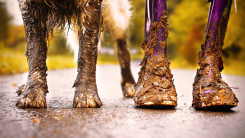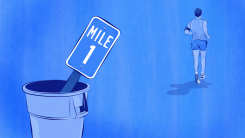Embrace the Cold and the Mud, Like the Swedish Do

I don’t own an umbrella. The logic behind that is simple: If it’s raining, I’m not going outside. Rain is just one on a long list of excuses I use to justify staying indoors (also on the list: all other forms of precipitation, temperatures outside the range of 50-90℉, dirt, and mosquitos).
The benefits of spending more time outside and in nature are well-documented, but it’s hard to build a daily fresh air habit when you have so many excuses to stay sheltered. I’ve confronted this reality again while reading There’s No Such Thing As Bad Weather by Linda Åkeson McGurk, a Swedish mom who compares her childhood experience in Scandinavia with raising children in the United States. If you want to get a hint of the primary differences, consider the book’s subtitle: “A Scandinavian Mom’s Secrets for Raising Healthy, Resilient, and Confident Kids (from Friluftsliv to Hygge).”
McGurk’s book contains quite a few practical tips for parents who want to give their children more time in nature, and they’ll also work for grown people who never got over feeling out of sorts when exposed to the outdoors).
Let go of excuses to stay inside (like the weather)
First, I (and perhaps you) need to let go of the idea that the only proper weather for outdoor activities is sunny, mild, and stable. Where I live in San Antonio, Texas, we experience 53 days of rain a year. Four months of the year are too cold for me, while three months are insufferably hot. You can see how it’s not hard to talk myself out of going outside for most of the year. How often is your local weather keeping you away from nature?
This isn’t to say you should abandon common sense and go outside whatever the conditions. As McGurk writes, “Thunderstorms, tornadoes, hurricanes, flash floods, life-threatening temperatures, or other types of crazy weather conditions are perfectly valid reasons for staying inside.” But if it’s just not ideal—a little chilly, a little too warm, a bit drizzly or grey—that’s not really worth staying cooped up, and sacrificing the benefits of getting out.
Maybe your excuse-making goes beyond the weather:
-
“I don’t have time.”
-
“I don’t want to get dirty.”
-
“The mosquitos are diabolical.”
You need to get used to making “going outside” a nonnegotiable part of your routine. Once that’s decided, it will be easier to see all the options for doing it safely and more comfortably.
Stock up on proper outdoor clothes
Do you catch yourself thinking inadequate outerwear will lead to viral illness, even though your logical mind knows that doesn’t make sense? Once you commit to spending time outdoors no matter what, start collecting the components of a weather-ready wardrobe. A well-planned ensemble can mitigate just about any weather-related discomfort.
McGurk says to look for these things in outdoor gear and play clothes for children (or adults):
-
Protects against the elements (wind, sun, moisture, cold temperatures, etc.)
-
Stands up to wear and tear
-
Easy to put on and take off
-
Loose-fitting enough to allow for range of motion while playing
Depending on the season and your climate, also consider:
-
For warmth, use a base layer of wool or synthetic material, a mid-layer of fleece or sweats, an outer layer that is waterproof, windproof, and breathable, and waterproof boots and mittens.
-
Consider rain pants, jacket, and boots for wet seasons.
-
Choose “play” clothes that won’t stress you if they get stained or torn.
-
Shoes are optional in the summer.
Practice Friluftsliv (open-air life)
According to McGurk, the Swedish word friluftsliv describes, “a culture and a way of life that heavily revolve around exploring and enjoying nature in a noncompetitive fashion.” You could call the Swedes’ commitment to outdoor living almost religious. “Some even suggest that nature fills the void left by the decline of organized religion in Sweden, which is now one of the most secular countries in the world,” she writes.
Their culture of open-air living may also mitigate our modern tendency toward sensory overwhelm, as observed in nature-based schools. “Nature activates all the senses, but without being overwhelming. When children play in nature, they tend to be calm yet alert,” McGurk advises. The calming-activating quality of nature can help adults regulate too.
Try these tips for more friluftsliv:
-
Eat meals outside whenever possible.
-
Take your coffee or tea outside.
-
Open windows.
-
Find a cozy outdoor chair to sub for your usual indoor nest for reading and scrolling.
Nap outside
If it’s not your cultural norm, you might be appalled to see a mother park her baby outside for a nap. However, in Scandinavia, it’s not only considered normal, but beneficial to let tiny children sleep outside. “Daily fresh air is seen as essential for babies, ranking just behind food, sleep, and the nurturing love of a parent. And the most common way for them to get their fresh air is from the comfort of a pram,” McGurk writes.
You may understandably not be interested in the scrutiny that could come with letting your infant sleep outside unattended. However, consider ways that you and/or your children could safely catch a nap outdoors. A daybed on the porch? The hammock you’ve always dreamed of in your backyard? This is your reminder that not only do you deserve the rest, the fresh air will be good for you.
Adopt a caretaker attitude toward natural spaces
As McGurk describes, some Swedish towns have made areas un-drivable to encourage other forms of travel and reduce the environmental impact of fossil fuels. One has no choice but to bike or walk in the fresh(er) air when downtown streets are closed and neighborhood roads dead end in green spaces.
Policies that transform the infrastructure of a community make all of its citizens partners in caring for the space and the environment. Scandinavian children start to understand their role in preserving the environment very early.
“On top of making sure that children have an opportunity to play in natural environments, the preschool is tasked with helping them understand how they can contribute to a better environment, both now and in the future,” McGurk writes.
You and your children can spend more time outdoors and engage more personally with caring for nature with these activities:
-
Take a class outdoors, learning an outdoor skill.
-
Compost as the first step to growing something yourself. Gardening doesn’t have to be a huge investment of space, time, and energy. Start with one pot and one seed.
-
Keep bags and gloves handy to pick up litter as you move through the community.
Embrace the dirt and rain
Consider how much your discomfort with dirt is rooted in fear of judgment. As McGurk notes, it might be time to separate the ideas of dirt that comes from play and dirt that comes from neglect. “Sometimes it’s adults’ own fears that keep children from having sensory experiences in nature … parents who do let their children kick their shoes off in public run the risk of getting shamed. Going barefoot, like so many other things that used to be a common part of childhood in the US, has now become controversial,” she writes.
Try designating a “muddy zone” in your yard where digging and exploration is encouraged. If you get anxious about the mess trailing inside, set up a station and routine for shucking muddy gear at the door. Practice prioritizing daily outdoor time — regardless of weather — until it is simply part of your routine.
“Remember that not every nature experience must entail a grand adventure to a scenic national park—watching a caterpillar make its way across a sidewalk or simply lying in the grass and watching the clouds go by in the backyard can be a great adventure to a small child,” McGurk writes. “Celebrate these everyday nature experiences together, and come back to the same places often to make sure your child forms a bond with your community and its natural areas.”



